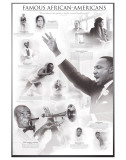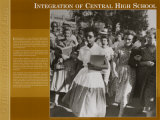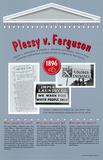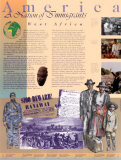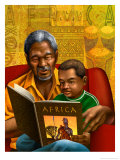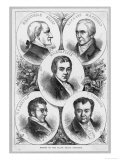|
|
African-American, Black History, & Civil Rights Educational Posters, Prints, & Charts Index
for Black History Month in social studies classrooms, home schoolers, theme decor for offices.
|
social studies > BLACK HISTORY INDEX < history
|
|
Black History celebrations, first as a week of commemoration and then as a full month, have been recognized annually since 1926. February was chosen as Black History Month by Dr. Carter G. Woodson because Frederick Douglass, Langston Hughes and Abraham Lincoln were born in February. Rosa Parks was also born in February (1913), but as of the establishment of Black History Month, her great contribution to Civil Rights was almost 30 years in the future. [more February posters]
|
|
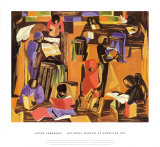 |
African American Artists-
Edward Bannister, Allan Rohan Crite, Minnie Evans, Palmer Hyden, Malvin G. Johnson, William H. Johnson, Jacob Lawrence, and Alma Woodsey; Lois Mailou Jones
|
|
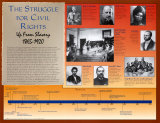 |
Civil Rights Posters
|
|
 |
Great Black Americans Posters Series -
Benjamin Banneker, Ralph Bunche, George Washington Carver, Shirley Chisholm, Frederick Douglass, Charles Drew, W. E. B. DuBois, Ella Fitzgerald, Langston Hughes, Rosa Parks, Sojourner Truth, Harriet Tubman, and Booker T. Washington
|
|
 |
Great Black Innovators -
Benjamin Banneker, Mary McLeod Bethune, George Washington Carver, Charles Drew, Katherine Dunham, Matthew Henson, Elijah McCoy, Charlie Parker, Madame C. J. Walker
|
|
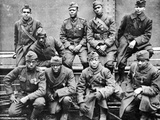 |
Black Military History Posters
Black Civil War units, the famous Buffalo Soldiers, the Tuskegee Airmen and the 369th Infantry Regiment (WWI), and more...
|
|
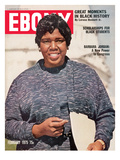 |
Outstanding Contemporary African Americans Poster Series -
Malcolm X, Barbara Jordan, Jesse Jackson, and Toni Morrison
|
|
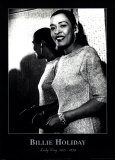 |
Musicians & Entertainers Posters -
Jazz, Blues ....
|
|
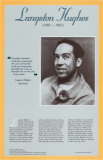 |
African American Writers Posters
Maya Angelou, James Baldwin, Countee Cullen, Frederick Douglass, W. E. B. DuBois, Paul Lawrence Dunbar, Ralph Ellison, Lorraine Hansberry, Langston Hughes, Zora Neale Hurston, Harriet Jacobs, Toni Morrison, Jean Toomer, Richard Wright
|
|
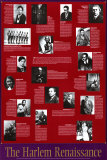 |
Harlem Renaissance Posters
Stars of the Harlem Renaissance, The Harlem Renaissance composite poster, Harlem Renaissance Culture Guide Poster Map
|
|
|
Harriet Tubman, Sojourner Truth, Mary Ann Shadd, Rosa Parks, Jesse Owens, Robert Johnson, Louis Armstrong, Jackie Robinson, Sidney Poiter.
|
|
|
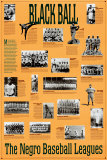 |
Black History & African American Athletes Posters & Art Prints
Baseball and more...
|
|
 |
Kwanzaa Holiday
Kwanzz is a cultural holiday observed from December 26 to January 1 every year. It was created by Dr. Maulana Karenga in 1966, based on several African harvest festivals.
|
|
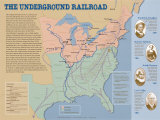 |
The Underground Railroad Posters
As many as 100,000 “passengers” used the Underground Railroad “depots”, with the assistance of “conductors” and “station masters” between 1830 and 1861, to escape slavery.
|
|
|
|
|
|
|
|
|
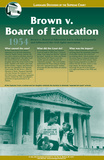
Brown v
Board of Education
poster no
longer available
|
Brown v Board of Education Topeka, Kansas
5-17-1954 - “Separate educational facilities are inherently unequal.”
What caused the case? In 1951, Karen Brown was denied admission to an all-white elementary school in Topeka, Kansas. Instead, she was told to attend an all-black school in another neighborhood. Her father sued the school district for not letting his daughter attend the school closest to her home. Together with similar cases from South Carolina, Virginia an Delaware, the case was appealed to the Supreme Court under the title, Brown v. Board of Education of Topeka. Thurgood Marshall, who later became the Supreme Court's first black Justice, argued fhat segregated schools violated the 14th Amendment's guarantee of equal protection to all citizens.
What did the court do? - In an unanimous decision, the Supreme Court set aside its 1896 Plessy v. Ferguson ruling. That ruling had allowed “separate but equal” facilities for whites and blacks. Chief Justice Earl Warren wrote that racially separate public schools are always wrong – no matter how “equal” in quality. The Court further undermined the Plessy ruling by finding that such “separate but equal” facilities do encourage the idea that blacks are inferior to whites.
What was the impact? Brown v. Board of Education of Topeka did not bring about the immediate integration of all public schools. But it did have far-reaching effects. School systems across the nation began to integrate blacks into what had been all-white schools. Many began busing programs in an effort to balance the mix of races. And to a very large degree, the decision helped encourage the growth of the historic civil rights movement of the 1950s and 1960s.
• background on Brown v Board of Education
|
|
|
|
Plessy v Ferguson
5-18-1896, affirmed a ‘separate but equal’ policy that allowed widespread segregation to thrive in the South. Pless v Ferguson upheld the “Jim Crow” laws that helped maintain segregation in the South.
What caused the case? The case of Plessy v. Ferguson arose when Homer Plessy, a black man, objected to a Louisiana state law requiring separate railroad cars for black and whites. Mr. Plessy was arrested when he refused a condutor's order to sit in the car for black passengers. In a trial, Mr. Plessy was found guilty of breaking the law. In response, he sued the judge in the case, a man named John Ferguson. His suit claimed that the Louisiana law went against the Constitution's 14th Amendment, which guarantees to all citizens the equal protection of the laws.
What did the court do? - The Supreme Court reviewed Mr. Plessy's claim that the Louisiana law violated the 14th Amendment's equal protection guarantee. But the Court upheld the law. It agreed that the 14th Amendment did guarantee all citizens equal protection. However, it said that separate facilities did not take away this protection – as long as the facilities were truly equal. Moreover, it denied that such "separate but equal" facilities would necessarily make black feel inferior to whites.
What was the impact? In Plessy v. Ferguson, the court said it would allow “separate but equal” public facilities for blacks and whites. And in the years that followed, many states did set up racially separate public facilities. But these facilities were seldom equal. In fact, accommodations for whites were almost always superior to those for blacks. In effect, the ruling made it easier for widespread segregation to exist throughout the South and elsewhere for more than 50 years.
• background on Plessy v Ferguson
|
|
|
|
|
|
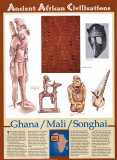 |
Ancient African Civilizations Poster Series-
Benin, Egypt, Ethopia, Ghana/Mali/Songhai, Zimbabwe
|
|
|
|
|
|
|
|
|
In 1787 William Wilberforce, an independent Member of Parliament, met with Thomas Clarkson and a group of anti-slave-trade activists that included Granville Sharp, Hannah More and Lord Middleton, who persuaded Wilberforce to take on the cause of abolition.
|
|
previous page | top
|
|
I have searched the web for visual, text, and manipulative curriculum support materials - teaching posters, art prints, maps, charts, calendars, books and educational toys featuring famous people, places and events - to help teachers optimize their valuable time and budget.
Browsing the subject areas at NetPosterWorks.com is a learning experience where educators can plan context rich environments while comparing prices, special discounts, framing options and shipping from educational resources.
Thank you for starting your search for inspirational, motivational, and educational posters and learning materials at NetPosterWorks.com. If you need help please contact us.
|
|
|


















